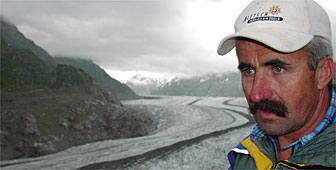Glacier survives global warming for another day

swissinfo.ch travel editor Dale Bechtel braved a downpour to take a close look at the first natural World Heritage Site in the Alps.
We set out to explore the Aletsch Glacier, the jewel of the “Jungfrau-Aletsch-Bietschhorn” site, despite heavy rain, a threat of mudslides and fears that the ice sheet would melt away before our very eyes.
“We don’t take any risks … but if life gets boring we’ll risk it,” warned mountain guide Martin Nellen, responding to whether our hike to the Aletsch Glacier would be in vain.
I had joined journalists and dignitaries from more than 20 countries, who had travelled to canton Valais for the unveiling of the World Heritage Site.
The Aletsch Glacier is the longest in the Alps at more than 23 kilometres, and the region was inscribed as a World Heritage Site by Unesco last December.
Receding glacier
As part of the ceremony, we were promised the chance to walk across the moving mass of ice that is receding by about 30 metres a year, while at the same time dropping more than a metre in depth.
But we were told that before we could set foot on the glacier, we had to hike for five hours. As we descended a steep slope, it began to rain. Fortunately, our waterproof clothing proved resistant, and we remained determined.
“I think it must be difficult to walk on a glacier,” offered Wolfgang Wissler, a journalist from the southern German town of Constance. He was sporting a light raincoat and a navy blue cap with “Jungfraubahnen” written across it – a freebie from Jungfrau Railways. “I’ve never been on a glacier before, but I’m very excited to find out what it’s like.”
Nellen pulled out a map. “That’s our glacier,” he said, pointing out the location of the Eiger, Mönch and Jungfrau mountains in relation to the ice mass, since low, black clouds had obscured the high peaks.
Global warming
Our guide then provided us with lots of facts and figures about the glacier and its scientific importance for studying climate change. Increased precipitation in the Alps is one symptom of global warming – something we were experiencing first-hand. The steady rain turned into a downpour, penetrating our “waterproof” defences.
We found ourselves in a shallow depression, between rocky glacier deposits and a mountain slope. “From here we have to walk down about 200 metres to get to the glacier,” explained Nellen. “That means the glacier has dropped about 200 metres in the last 150 years.”
As we walked through puddles on an increasingly muddy path, Wissler said he was impressed by what he had seen, even though he realised the chances of getting onto the glacier in these conditions were becoming more remote.
Respect environment
“It has made me aware that mountains are not a playground, but a natural environment deserving respect,” he said.
After an hour and a half, we reached the edge of the glacier. It no longer appeared to be a flat sheet of ice, but an impressive mass of breaking waves, as if frozen during a prehistoric storm. However, the rain continued to fall, dampening our chances of actually stepping onto the glacier.
Nellen joked that the rain had made it as slippery as ice. Since we had not been issued with crampons, it really was too dangerous to set foot on the glacier. Our guide then began to worry out loud about the threat of a mudslide on the slope that we had descended and would have to climb back up.
Once we had made it to safety, Wissler reflected on his adventure: “The rain is also a story … seeing the glacier in the rain.”
by Dale Bechtel
The World Heritage Site
Local officials and interest groups have three years to agree on a “management plan” for the Jungfrau-Aletsch-Bietschhorn site. They have to present Unesco with a plan that will, according to the Paris-based World Heritage Centre, ensure that tourism at the site is “environmentally sound and sustainable”. Open for discussion are the creation of information centres and the deployment of park rangers.
The World Heritage Site is best approached from either Grindelwald or Wengen in the Bernese Oberland, or from Bettmeralp or Riederalp in canton Valais. Bettmeralp and Riederalp see far fewer tourists in summer, including the large tour groups that are drawn to Grindelwald in particular.

In compliance with the JTI standards
More: SWI swissinfo.ch certified by the Journalism Trust Initiative

You can find an overview of ongoing debates with our journalists here. Please join us!
If you want to start a conversation about a topic raised in this article or want to report factual errors, email us at english@swissinfo.ch.